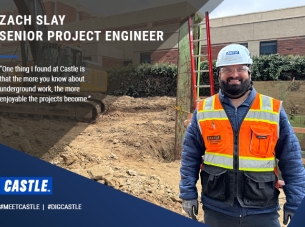A Bright Future: Solar Site Evaluation and Preparation Accelerates
Renewable Energy: Solar Farm Preparation
Solar power is a vital tool in the world’s mission to reduce carbon emissions. As more municipalities and states invest in building utility-scale solar power installations, it’s important that experienced contractors are on hand to meet strict schedules, follow regulatory and permitting direction, and play a role in managing these complex projects. From the start of the solar farm project proposal to completion, it’s more important than ever to get things right the first time and on schedule.
The solar farm construction process is becoming more streamlined as technologies improve and adaptation becomes more cost-effective. Utility-scale solar photovoltaic (PV) site preparation includes a lot of variables that need to be accounted for including time.
The Future of Solar Photovoltaic Energy
The world is currently in a race to reduce carbon emissions. In the race against climate change, trends in government spending have spurred discussion and deployment of solar in sun-rich communities. However, even with the rapid acceleration of solar efficiency, cost-effectiveness, and deployment, we have a long way to go. Global solar capacity would need to reach 18 times its current levels by 2050 to meet America’s climate goals.
Economic forces are also pulling in solar’s direction. Solar energy cost per kWh now averages 3 to 6 cents compared to 5 to 17 cents for fossil fuels. Renewables are less expensive, which is driving forward-thinking businesses, cities, and states to invest.
Solar Site Evaluation
Whether a solar installation project covers a few hundred or a few thousand acres, a solar site evaluation is an important step in maximizing its potential. Contractors work to identify any possible complications associated with a potential solar site.
Some important site considerations include:
- Correct orientation of solar panels
- Immediate and long-term issues with shading from the tree line or nearby buildings
- Ideal panel mounting system
- Drainage and soil composition
The Perfect Solar Project Location
In most cases, local commercial construction companies have already worked with landowners, developers, and both municipal and state bodies to identify locations best suited for solar development. These locations aren’t uniform, but they do share common characteristics:
High Energy Density. Energy density refers to the amount of direct sunlight. Locations closest to the equator tend to have the highest energy density; these areas see the most (and most consistent) direct sunshine annually.
Limited Rain and Cloud cover. Rain isn’t a problem for solar panels themselves, which hold up to water incredibly well. The problem with moist climates with heavy rainfall and cloud cover is the reduction of sunlight.
Higher Elevation. The higher the elevation of a solar farm, the less atmospheric absorption of solar radiation occurs. This is a positive quality, as solar radiation is what makes a photovoltaic panel energy efficient. Higher elevations also have less air pollution, which can improve solar panel efficiency.
Soil composition. Solar farm materials weigh hundreds of tons. Solar site excavation contractors like Castle Contracting play a vital role in giving solar farms a firm and reliable foundation. This prevents sinking, shifting, panel damage, and erosion problems.
In summary, the perfect solar farm site is one at high elevation, in a dry climate, with firm soil that drains well. Ideally, it is also near the equator. It’s no wonder that some of the most ambitious solar projects are focused in the American southwest and central regions.
Is a Large-Scale Solar Farm Project More Difficult Than a Smaller One?
Based on Castle’s experience of working on projects ranging from 30 to 4,000 acres, the real challenge isn’t the size of the solar farm but putting equipment and people in the right place at the right time across multiple locations. As these types of projects become more popular, that challenge may grow.
As Project Director Dan O’Neal has noted, the appeal of solar projects is widespread, and for ambitious solar preparation projects, resources and schedules are limited. He explained, “Schedules are usually the same no matter the project scale, so it comes down to getting people and equipment to these remote locations. There’s also the added risk of more water runoff and storm damage as scale increases.”
At any given time, Castle might be working on solar projects in several states across the country in various stages of construction. That requires excellent communication and logistics.
Bringing Utility-Scale Solar to Life
Castle Contracting brings a wealth of experience to creating a new solar farm. Our proven track record of building relationships with utility companies and landowners gives us an insider’s knowledge of processes that keep the project on schedule. Steps such as identifying the right materials and location are an important part of meeting deadlines.
Ground Mounting Systems of Solar Panels
While roof-based solar mounting is a popular and important way to bring solar to more places, ground mounting systems offer many advantages. First, the modular nature of ground mounting systems makes projects more scalable and efficient. Using the terrain and various mount options, one can position the panels to get more light, more consistently, with fewer requirements for maintenance and logistical support.
Utility Scale PV Site Preparation
Every solar project presents unique challenges and considerations. Dan O’Neal, Project Director and expert on solar site construction, is quick to note that meeting deadlines takes a lot of flexibility and quick thinking. “We’ve worked nights and weekends after storms dumped four to six inches of rain on a site.” Amidst all these moving pieces, we were able to perform our typical clearing, grading, excavation, soil remediation, and trenching services to help keep all contractors in a position to succeed.
Breaking Ground Sustainably
There’s an unfortunate conception that preparing ground for a solar farm degrades the land. Most projects use the natural terrain to enhance the efficiency of the panel arrays and strive to keep excavating needs to a minimum. Our process for solar farm site preparation includes an effort to consider soil and erosion, pollinator health, and the health of other wildlife.
Solar farms are being used to enhance pollinator habitats, too. Cornell University is studying the suitability of solar arrays as a potential home for bees. The three-year study includes solar projects across the country and hopes to educate developers and support agricultural communities by providing safe habitat for bees.
Sustainability informs every solar panel site proposal, and it stays a top priority throughout the preparation process.
What Is the Timeline of Solar Site Preparation?
On average, solar site preparation takes four to six months, according to Dan O’Neal at Castle Contracting. That timeline relies heavily on getting enough people and equipment to the project location, plus successfully adapting to soil composition and stormwater permits. As a result, most projects are completed in more than a year.
That pace is more impressive when you consider the amount of solar energy potential. O’Neal identified the output as the biggest difference when comparing these sites: “A couple of years ago, you’d see sites building 100 Megawatts, and now we’re seeing projects as large as 500 Megawatts.” That will lead to more incentives for developers to use economies of scale to improve efficiency and maximize output for each installation.
Preparing the World for a More Sustainable Future
Castle is an industry leader in site preparation for solar projects at any scale. As interest in alternative energy sources increases, utility-scale solar projects play a central role in bringing renewable energy to communities across the country. Learn more about our process and capabilities by contacting us today.







